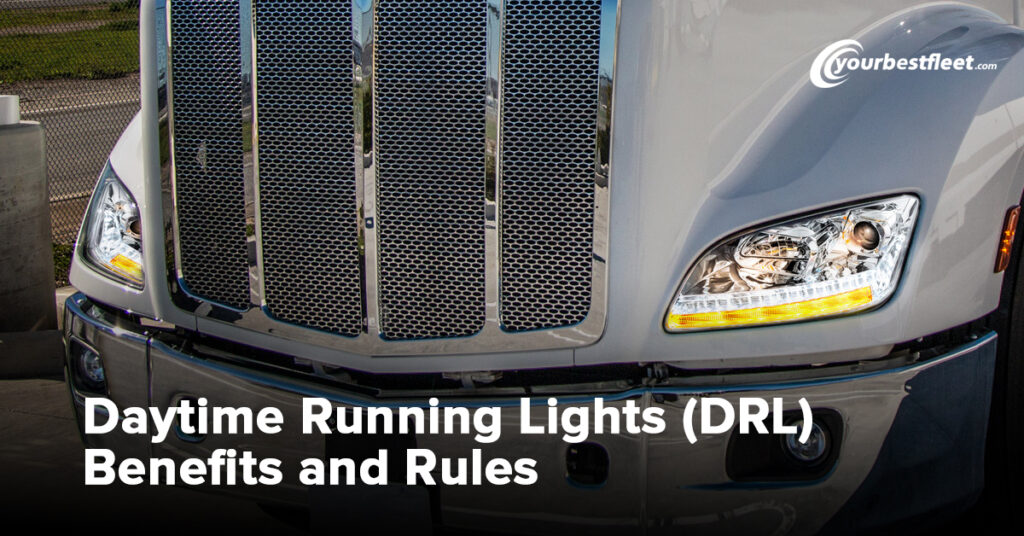Key Takeways
- They use LED tech, ensuring efficiency and longevity.
- DRLs cut daytime crashes by 10-15%, especially in low-light.
- Rules vary by location, with some mandating year-round use.
- Myths are false—DRLs don’t waste fuel or drain batteries.
What are DRLs?
Daytime Running Lights (DRLs) are low-intensity lights that operate during the daytime to make vehicles more visible. Unlike headlights, DRLs do not improve nighttime visibility and are not required to illuminate the road ahead. They are located on the front of the vehicle and turn on automatically when the engine starts.
DRLs use LED, halogen, or dimmed high-beam bulbs. They are separate from headlights and fog lights, meaning they do not interfere with night driving or weather-based lighting systems.
Features of Daytime Running Lights (DRL)

Automatic Activation
Automatic activation ensures that DRLs turn on as soon as you start the engine, keeping your vehicle visible at all times. They function during daylight hours and automatically switch off when headlights are in use. This prevents unnecessary glare at night while ensuring continuous safety during the day.
Improved Visibility
Improved visibility helps other drivers, pedestrians, and cyclists see your vehicle more clearly, reducing accident risks. DRLs are particularly useful in fog, rain, and overcast conditions where visibility is lower. By increasing awareness on the road, they contribute to safer driving environments.
Energy Efficient
Energy efficiency allows DRLs to operate without using much power, as they often rely on LED technology. Unlike traditional headlights, they consume minimal energy, reducing strain on the vehicle’s battery. This ensures they enhance safety without negatively affecting fuel consumption or electrical performance.
Enhanced Road Safety
Enhanced road safety is a key benefit of DRLs, as they make vehicles more noticeable, reducing daytime collisions. Many countries have implemented DRL requirements to improve traffic safety and lower accident rates. Their constant illumination helps drivers react faster to oncoming traffic and potential hazards.
Long-Lasting Performance
Long-lasting performance ensures that DRLs require little to no maintenance, lasting the lifetime of the vehicle. Since they do not need frequent replacements like traditional bulbs, they help reduce overall maintenance costs. Their durability makes them a reliable safety feature for all driving conditions.
How Do Daytime Running Lights (DRL) Work?

DRLs function automatically and do not require manual activation. They work by:
- Turning on when the engine starts.
- Switching off or dimming when headlights are activated.
- Using low-power lighting that does not drain the battery significantly.
- In some vehicles, adjusting brightness based on ambient lighting conditions.
DRLs are often integrated into LED strips, high-beam bulbs, or separate lamps, depending on the vehicle model.
Benefits of Daytime running lights (DRLs)

Increased Vehicle Visibility
- Enhances the ability of other drivers, pedestrians, and cyclists to detect the vehicle.
- Reduces lane-change and merging-related accidents.
Lower Risk of Daytime Accidents
- Studies show DRLs can reduce daytime collisions by 10-15%.
- Particularly effective in low-light conditions, fog, and rainy weather.
Automatic Safety Enhancement
- No need for manual activation.
- Works independently of headlights and fog lights.
Stylish and Modern Appearance
- Many DRLs feature LED designs that improve vehicle aesthetics.
- Enhances the premium look of newer cars.
Energy-Efficient and Long-Lasting
- LED DRLs consume less power than traditional headlights.
- Designed to last for years without replacement.
Improve road safety
- DRLs are a sensible option for all drivers since they greatly improve road safety.
- Particularly during the day, their enhanced brightness and visibility contribute to a decreased chance of collisions.
DRL Rules in Different States

DRLs are proven to be an essential safety element in cars by improving visibility throughout the day and promoting road safety. Since 1996, DRLs have been a requirement for U.S. vehicles.
As of 2021, headlight use during daytime hours is required in 32 states in the United States. Since DRL standards vary from state to state, it’s important to know about the regulations in the state you are operating in.
State-Wise DRL Needs
- States have different rules for DRL regarding where, when, and the kind of lights to use.
- While some states mandate that all vehicles use DRL throughout the year, others only require it during particular months or hours of the day.
- Certain lighting fixtures, like LED lights or high-beam headlamps, can be required.
- It’s crucial to keep up with the particular DRL rules in your state if you want to stay out of trouble.
Penalties for Failure to Comply
- The severity of the penalties for breaking DRL rules varies from state to state and situation to situation.
- In certain states, financial penalties can vary from $50 to more than $250.
- In some circumstances, there may be more severe penalties, including license suspensions.
State-Specific Regulations
- States such as Alaska, California, and Michigan have year-round DRL requirements.
- Certain states, like New Hampshire or Illinois, only require DRLs during particular months or seasons of the year.
- Some states, like Hawaii and Vermont, mandate the use of high-beam headlamps as DRLs.
- In areas like Colorado and Oregon, DRLs must have LED lights installed.
Legal Implications
- Depending on the state and the situation, breaking DRL rules can result in penalties, license suspensions, or even jail.
- Certain states, such as Virginia and Florida, charge $50 to $250 in fines.
- Your license may be suspended if you have DRL offenses in Massachusetts and New York.
- Recurrent DRL offenses may result in jail time in several states, including Mississippi and Texas.
Types of Daytime Running Lights (DRL)

LED DRLs
- Energy-efficient and long-lasting.
- Used in most modern vehicles.
- Provide bright, clear visibility with minimal power usage.
Halogen DRLs
- Found in older or budget-friendly models.
- Less efficient than LED but still effective.
- Consume more power than LED alternatives.
High Beam or Low Beam DRLs
- Some vehicles use dimmed high beams as DRLs.
- Others use low beams at reduced intensity to function as DRLs.
Dedicated DRL Lamps
- Separate light units designed exclusively for DRL functionality.
- Common in premium vehicles.
Common Myths About DRL
How to Check If Your Car Has DRLs
To determine if your vehicle has Daytime Running Lights, try the following:
- Start your car in daylight – If front lights turn on without using the headlight switch, you likely have DRLs.
- Check your dashboard – Some cars have a DRL indicator light.
- Look in the vehicle manual – The owner’s manual will confirm whether your car includes DRLs.
Observe the front lights – DRLs should be on while the car is running but turn off when headlights are activated.
Can You Turn Off Daytime Running Lights?
Conclusion
FAQ
Do DRLs replace headlights?
No, DRLs do not replace headlights as they are designed for daytime visibility and do not illuminate the road at night.
Do DRLs consume a lot of energy?
No, DRLs use minimal power, especially LED versions, which are energy-efficient and do not significantly affect fuel consumption.
Are DRLs required by law?
Many countries mandate DRLs for new vehicles, while others have specific regulations depending on the region and driving conditions.
Do DRLs work at night?
No, DRLs are designed for daytime use and automatically turn off or dim when headlights are activated.
Do all vehicles come with DRLs?
No, while many modern cars have DRLs, some older or budget models may not include them.
Can DRLs be added to a vehicle that doesn’t have them?
Yes, aftermarket DRL kits are available and can be installed on vehicles without factory-equipped DRLs
Are DRLs the same as fog light
No, DRLs increase visibility in daylight, while fog lights are designed for use in poor weather conditions like fog, rain, or snow
James Johnson is a former truck driver who now works as a writer, specializing in the trucking industry. With over 15 years of experience on the road, James has a unique perspective on the challenges and opportunities faced by truck drivers and the trucking industry as a whole. His writing focuses on issues such as safety, regulation, and the latest industry trends. His work has been featured in several trucking publications and he has received recognition for his contributions to the industry. In his free time, James still enjoys being around trucks and often attends truck shows and other industry events.


